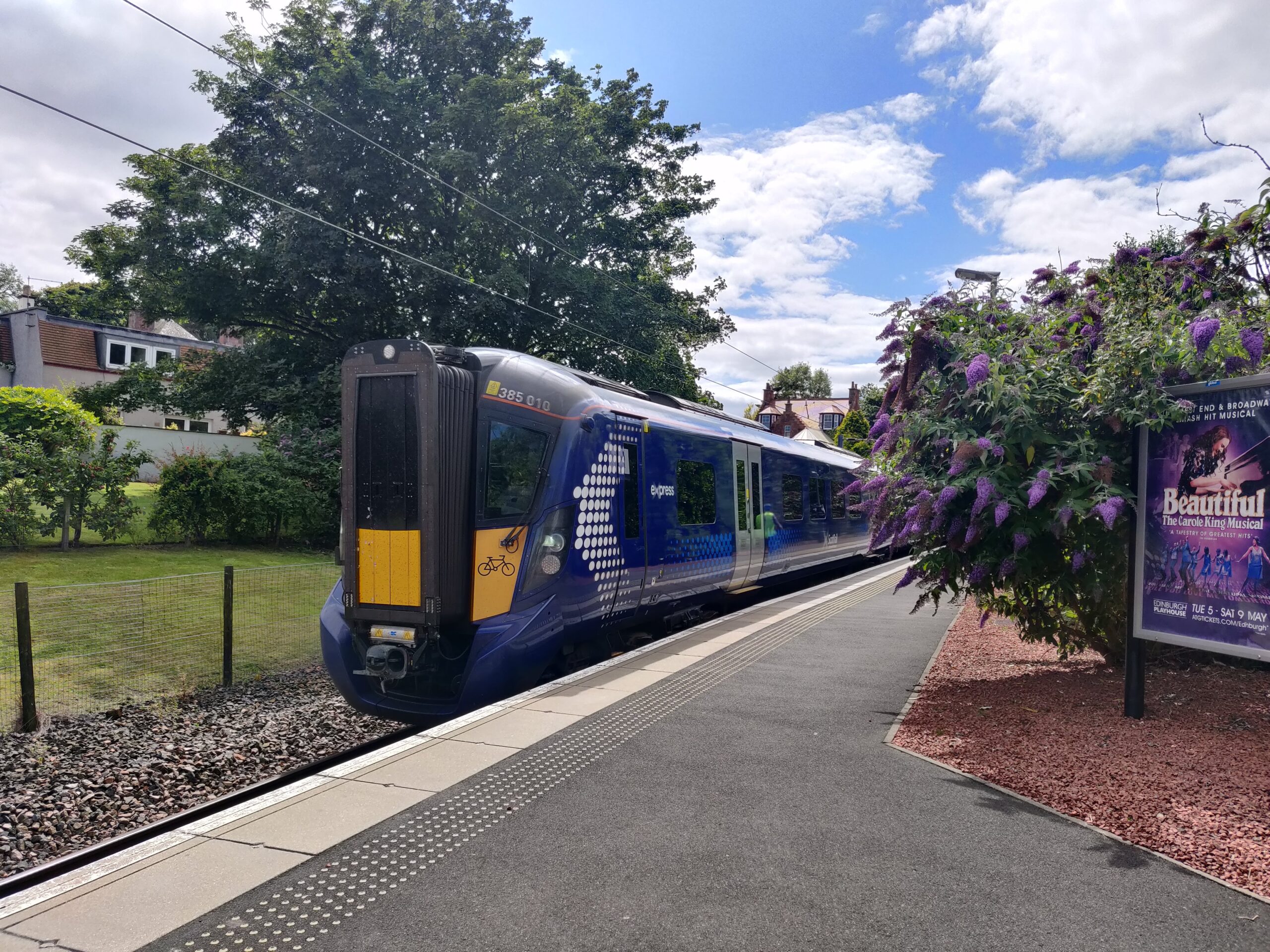Transport Scotland is considering a rationalisation of its passenger rail fleet and approached a number of its stakeholders for their views. Together with Friends of the West Highland Line, we prepared the following response.
Service Types
Transport Scotland’s initial proposal is for a fleet comprising four service types:
- Intercity – long-distance connection between Scotland’s cities.
- Outer Suburban or Regional – providing intermediate services betweenScotland’s cities and major towns
- Inner Suburban or Local – providing short journey services (not more than,say, about 40 mins) services to the commuter markets of Glasgow, Edinburghand potentially Aberdeen
- Rural or Scenic – operating on lines with low populations and high scenic value
It seeks comments on the number of service types, their characteristics and the routes on which they should operate.
We agree four categories are appropriate: InterCity, Regional, Local, Scenic. Electric Intercity trains would replace the current Inter7City HSTs. Regional would include trains between major conurbations, eg Glasgow-Ayr, Edinburgh-Glasgow, and longer distance secondary services serving smaller intermediate conurbations on routes between cities, eg Glasgow-Dundee calling at Stirling, Dunblane, Gleneagles etc. Local trains for suburban journeys would be expected to have high acceleration, high density seating and wide doors giving short dwell times.
“Scenic” would be trains for routes not likely to be electrified. In Transport Scotland’s decarbonisation programme, these are shown as West Highland, Far North, Kyle and Stranraer. As all these trains will operate for some part of the journey on sections of electrified route (eg Glasgow-Craigendoran, Glasgow-Ayr, Inverness-Dingwall-Tain) there is likely to be a place for hybrid overhead electric/ hydrogen trains (or possibly electric/battery for Stranraer). The “rural” description is not felt to be an appropriate term as these trains are operating on long routes of significance in the Scottish transport network.
Automatic Selective Door Opening (ASDO)
Transport Scotland believes that passenger growth is likely to be addressed by utilising longer trains rather than increased services. Infrastructure may dictate the length of train able to fully platform at a particular station therefore the use of ASDO, as used in Ayrshire and Inverclyde, may be an option. It seeks comments on the merits or otherwise of ASDO
We agree that ASDO would be advantageous for some routes. Platforms shorter than trains cause confusion and increase dwell times, for instance on some stations on the West Highland Line. ASDO would also allow longer trains to be operated on other routes where platform lengthening is impractical or not cost justified at particular stations. The on-train information system should be integrated with the ASDO system.
Positioning of Doors
Transport Scotland recognises that while trains serving longer distance journeys have tended to have end-doors, other services have had doors at 1/3 and 2/3 of the carriage reflecting the need for a higher frequency of stops and to facilitate shorter dwell times.
We believe that end-doors are best for InterCity and Scenic trains, insulating the passenger saloons from the disturbance and draughts from doors opening, and boarding and alighting.
On Regional and Local trains 1/3 and 2/3 door positions give faster access and also reduce the gap between train and platform on curved platforms. Turbostar trains have the optimum door positions. On Local trains doors should be wider with access designed for quick loading to reduce dwell time.
Gangways
Some trains have gangways at the cab ends to facilitate passenger distribution and to increase the flexibility of the train movement. Transport Scotland seeks views on the merits or otherwise of gangways on different service types.
Gangways should be provided in future electric InterCity trains to give the flexibility to operate multi-portion trains (eg Inverness-Glasgow/Edinburgh) while allowing the conductor and catering trolley to reach all coaches on the train.
Gangways at cab ends are currently provided on Regional trains allowing conductor/guard to reach both units on longer trains (also for the catering trolley on E&G trains). Cab-end gangways should continue on the Regional fleet.
Scenic trains (where strengthening is often needed in summer) should have gangways at cab ends to allow catering trolley and conductor to access all coaches on a multi-unit train. This is important on the West Highland lines with separate portions for Oban and Fort William/Mallaig.
Gangways at cab ends should not be needed on inner suburban local trains, where an important consideration is providing the maximum seating capacity.
Seating Layout
Currently Transport Scotland operates trains where the seating is presented in bays (i.e. seats facing each other) and in airline mode (seats facing in one direction). In most carriages standard seating is arranged in 2+2 configuration, in others it is 2+3. In some carriages with a business/First class offer seating is 2+1. On some trains there are fixed tables (full or half size) in bay seating areas whereas for airline configurations there are flip-down tables affixed to the back of the seat in front.
It seeks views on the relative proportion of bay and airline seating on different service types, the proportion of seats in 2+1,2+2 or 2+3 configuration, the number of spaces for disabled travellers, the type and size of tables and the provision for standing passengers.
2+3 seating should not be provided on any future trains as passengers often prefer to stand rather than squeeze into the middle seat. Also the gangways are narrow on 2+3 sections, particularly for people with luggage or large girth.
2+1 seating should be provided in first class on InterCity trains, with the fare differential between first and standard class set to encourage reasonable uptake of first-class travel.
Bay seating with tables is preferred by many passengers, but lone passengers or couples may prefer airline seating. A mix of seating arrangements is best.
On local and suburban trains, a seating layout similar to the Class 380 used on Ayrshire and Inverclyde lines would be good. Suburban trains for journeys of less than 40 minutes should have space for standing passengers.
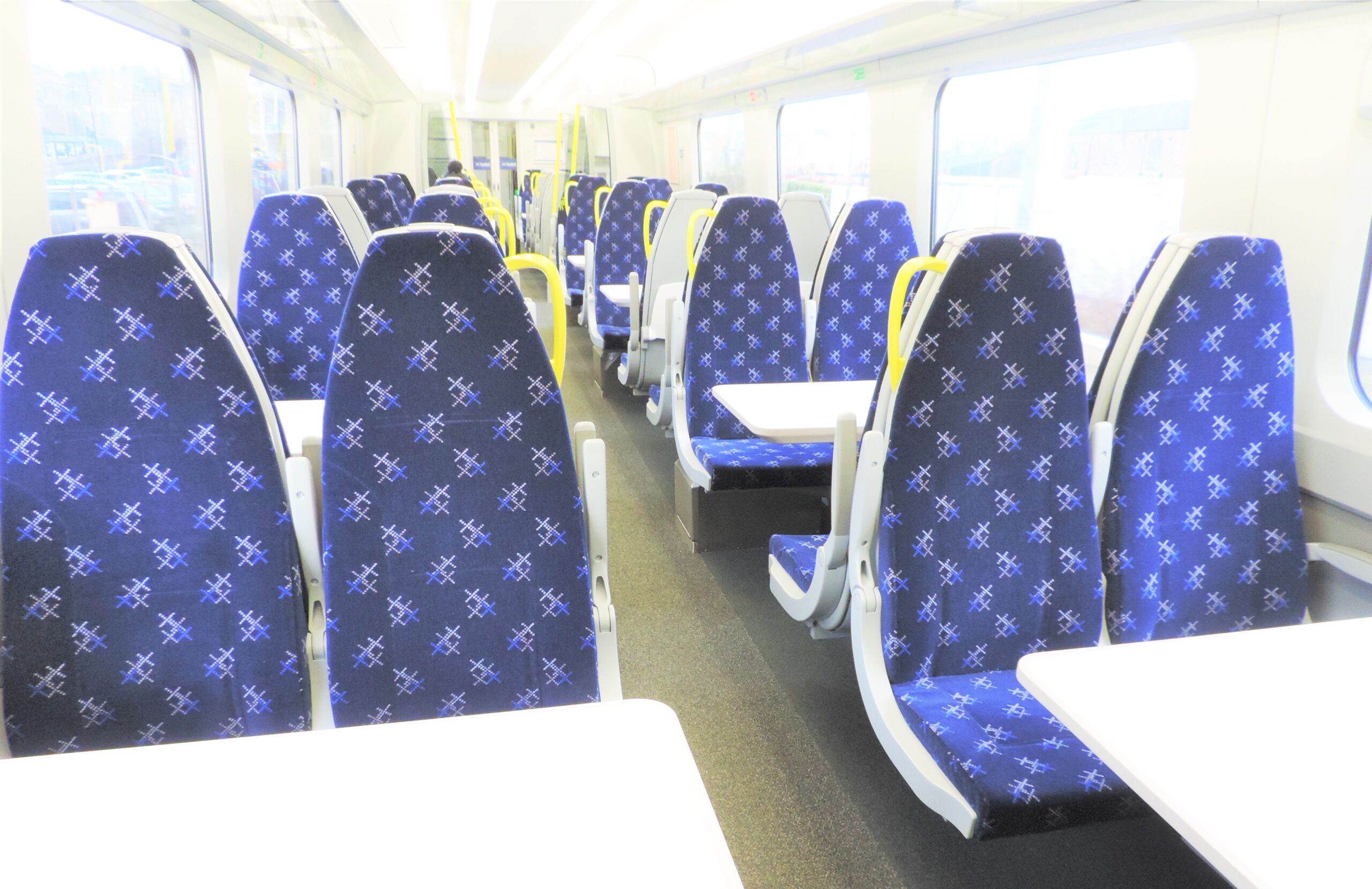
A greater proportion of bay seating would be more appropriate for scenic trains where views should be as unobstructed as possible. The refurbished ScotRail Class 158 with bay seating (above) compares favourably with the airline-style HS1 Javelin (below) for passenger views from the windows, though the ScotRail coach seats fewer passengers.
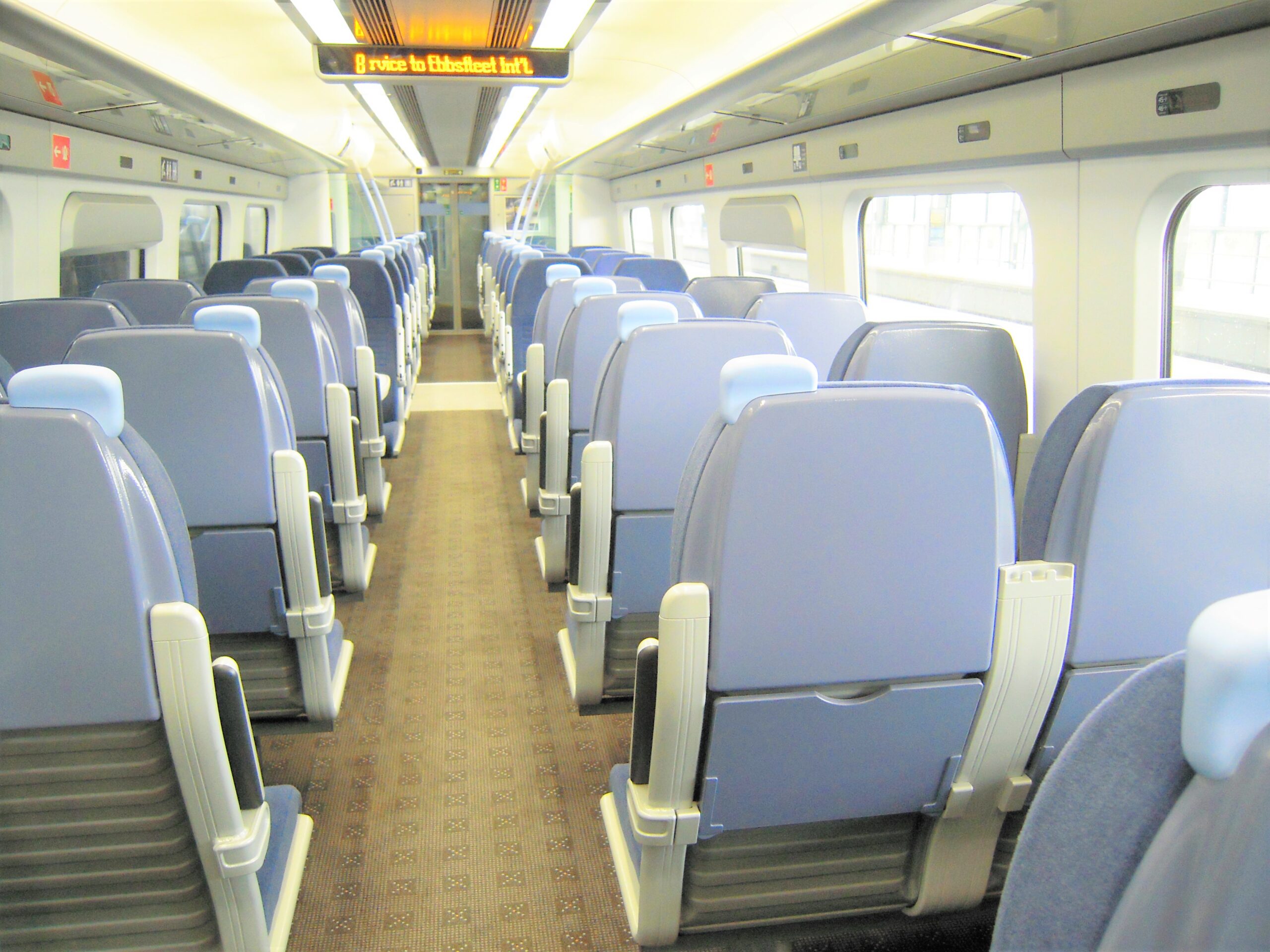
The proportion of bay and airline seats may have to be reviewed depending on health recommendations associated with the future evolution of covid-19 and other potential pandemics.
Deeper windows, as on some continental trains, improve the views from Tourist Trains.
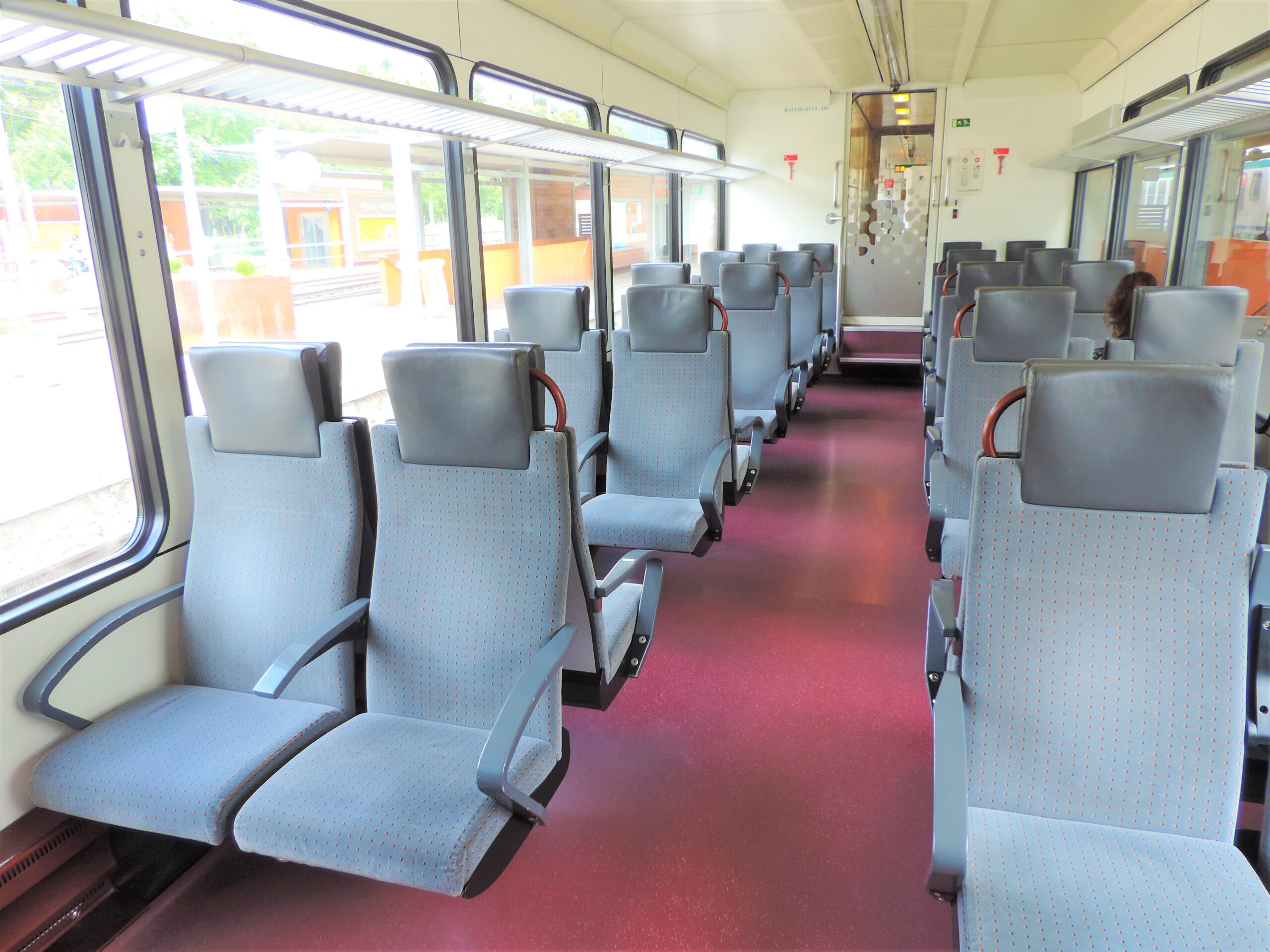
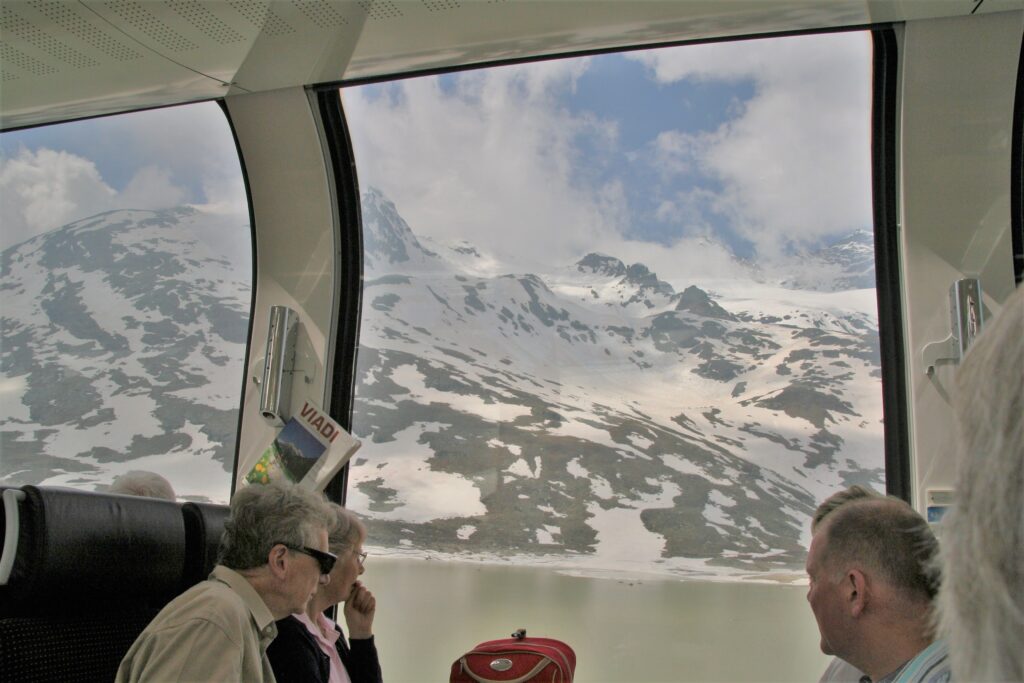
The Bernina coach has no above-window luggage racks. Higher platforms and lower train roofs in the UK would influence the design in this country. And lineside trees would need to be cut back to reveal the scenery.
The cost of seats is a relatively small portion of the total capital cost of a train but a prime factor in determining passenger comfort.
The comfort and quality of seats is important on InterCity and Scenic trains. Seats on Class 156 and 385 units have been described as hard, resembling ironing boards: survivable for 40 minutes but not 4 hours. Longer journeys on InterCity and Scenic trains need better upholstery, with comfort level and leg-room at least as good as car seats.
Toilets
Transport Scotland recognises that toilets are an important provision on board its trains and seeks comments of their provision and number (including Accessible Toilets) per different service type.
InterCity and rural/scenic trains should have one toilet per coach, with one in three being an accessible toilet (the current provision of one toilet per two-car Class 156 is inadequate for long journeys on the West Highland Line).
The distribution of toilets on Regional Class 380 and 385 trains seems reasonable and should be continued on future regional trains.
Local trains should have one accessible toilet per multiple-unit.
On trains with only one toilet, it is important that this should be maintained operational with a high degree of reliability.
Val Venosta train, South Tyrol (photo J.McCormick) Bernina Railway (photo David Murray-Smith)
Luggage Storage
The safe storage of luggage is a significant issue for travellers and the effective operation of services. Transport Scotland seeks views on the provision of overhead racks and luggage storage areas (including size and location) within each service type.
On InterCity and Scenic trains, large luggage racks should be available at the end of the coaches, as now. Overhead racks should also be provided. In bay seating areas, space for a small bag or case between seat backs is useful. Any areas with no window visibility should be used for an additional luggage stack in preference to installing seats with no view.
The design of scenic train luggage areas should contain an area for a range of items including rucksacks and sporting equipment like skis and fishing rods, possibly located with cycle spaces. But as mentioned in Section 8 below, the feasibility of providing tip-up seats should be considered to avoid space being wasted when not needed for luggage.
On local and regional trains, overhead racks should suffice. Overhead racks should have a transparent section to reduce the incidence of people leaving items on the rack. Space between seating bays could hold smaller cases.
Bicycle Carriage
The carriage of bicycles is a significant issue for some travellers. We would welcome comments on the carriage and location and number of cycle spaces (or dedicated carriages if appropriate) within each service type. And any operational observations that you may have.
The Scottish Government’s investment in dedicated cycle lanes is welcome and will make it easier for cyclists to make more journeys by cycle in urban areas, and fewer by train.
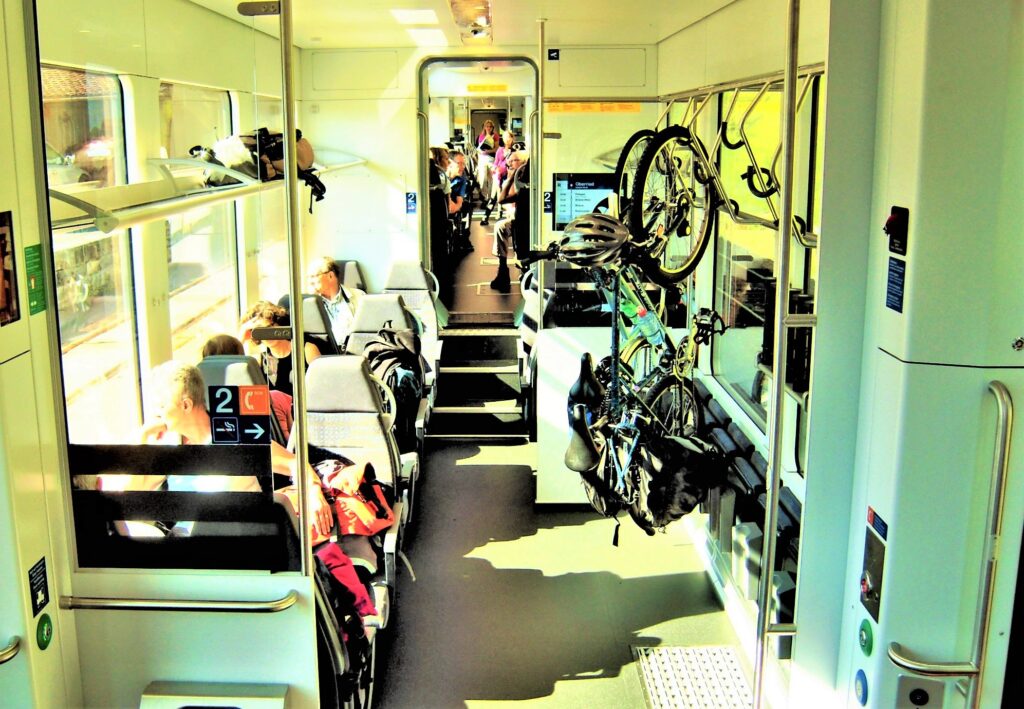
On tourist/scenic routes, where train lengths are limited and demand for cycle space is seasonal and varies by time of day and weather, cycle areas should have tip-up seats so that the space can be used by passengers when few cycles are on board, as seen (above) on metre gauge train from Interlaken to Luzern, Switzerland, and (below) regional train at Kitzbuhel, Austria.
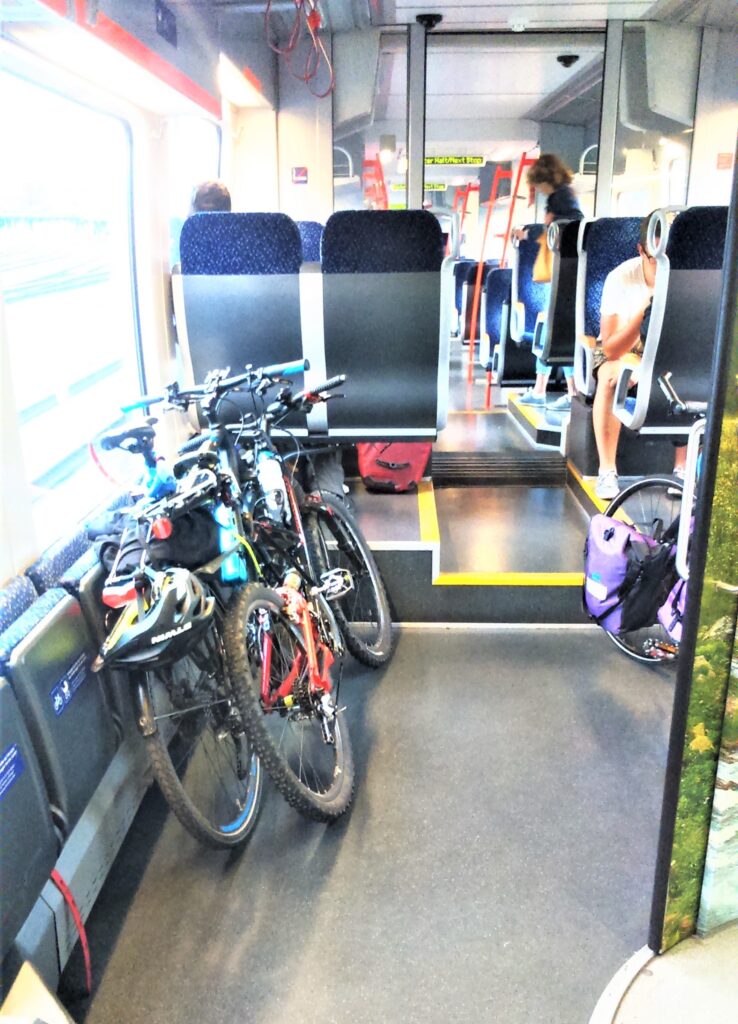

Catering
On many of our services catering is available. We would welcome comments on the appropriateness and provision of catering (buffet, trolley-service, vending machine) on each service type.
InterCity and most Scenic trains should have a catering trolley. Edinburgh-Falkirk-Glasgow trains (operated with Regional trains) should continue to have catering trolleys.
Floor furnishings
The floor furnishings on our current trains are either hard-wearing carpet or linoleum (cushion-flooring). We welcome comments on the type of floor covering for each service type.
InterCity and tourist/scenic trains should be carpeted.
Linoleum would be appropriate for regional and suburban trains.
Accessibility
It is important that we make travel accessible to all. We welcome comments on particular or additional facilities on each service type that ought to be provided to ensure that our trains are accessible to all.
Train floors level with platforms where possible would improve boarding for elderly and disabled passengers or people with prams. Extendable train steps would help at low platforms.
Attention also needs to be given to reaching the platform. Some stations have particularly difficult access for prams or wheelchairs, for instance many of the Cathcart Circle island platforms accessed by narrow and steep stairs.
Other Passenger Facilities
The needs of passengers are changing and we are keen to ensure that we have facilities that make rail travel attractive. We welcome comments on the provision and location of power points and data sockets (USB) as well as any further comments that you might have, for example, on ventilation, air-conditioning, heating, internal carriage design, size and position of windows (and the provision of blinds), lighting, information screens and devices for audio-announcements and location of litter bins for each service type.
Devices increasingly use USB for power, with traditional three-pin power less needed (USB usefully reduces the power that can be drawn).
Window blinds can cause arguments between passengers who prefer shade and those who want to look at the scenery: anti-glare tinted windows should be provided in preference to blinds.
Air-conditioning is essential on InterCity, Scenic and Regional trains. Following the covid-19 pandemic, air-conditioning with anti-viral filters will help to give re-assurance to passengers with health concerns. Emergency openable windows which could be unlocked by train staff would be necessary for situations where the air conditioning fails.
Local trains would not necessarily require air conditioning, though this would be preferred.
The main problem with the current information screens and audio announcements is that they are limited and frequently give the wrong station information (often one station out from the correct location) which can, and does, lead to passengers unfamiliar with the route missing their station or alighting at the wrong station.
A reliable GPS system, essential for ASDO, should be able to provide correct information to the screens and automated audio announcements.
Information screens should be sufficiently large to display real time train running information, and connecting train times and platforms at interchange stations, as in the illustration below on the Arlberg line in Austria.
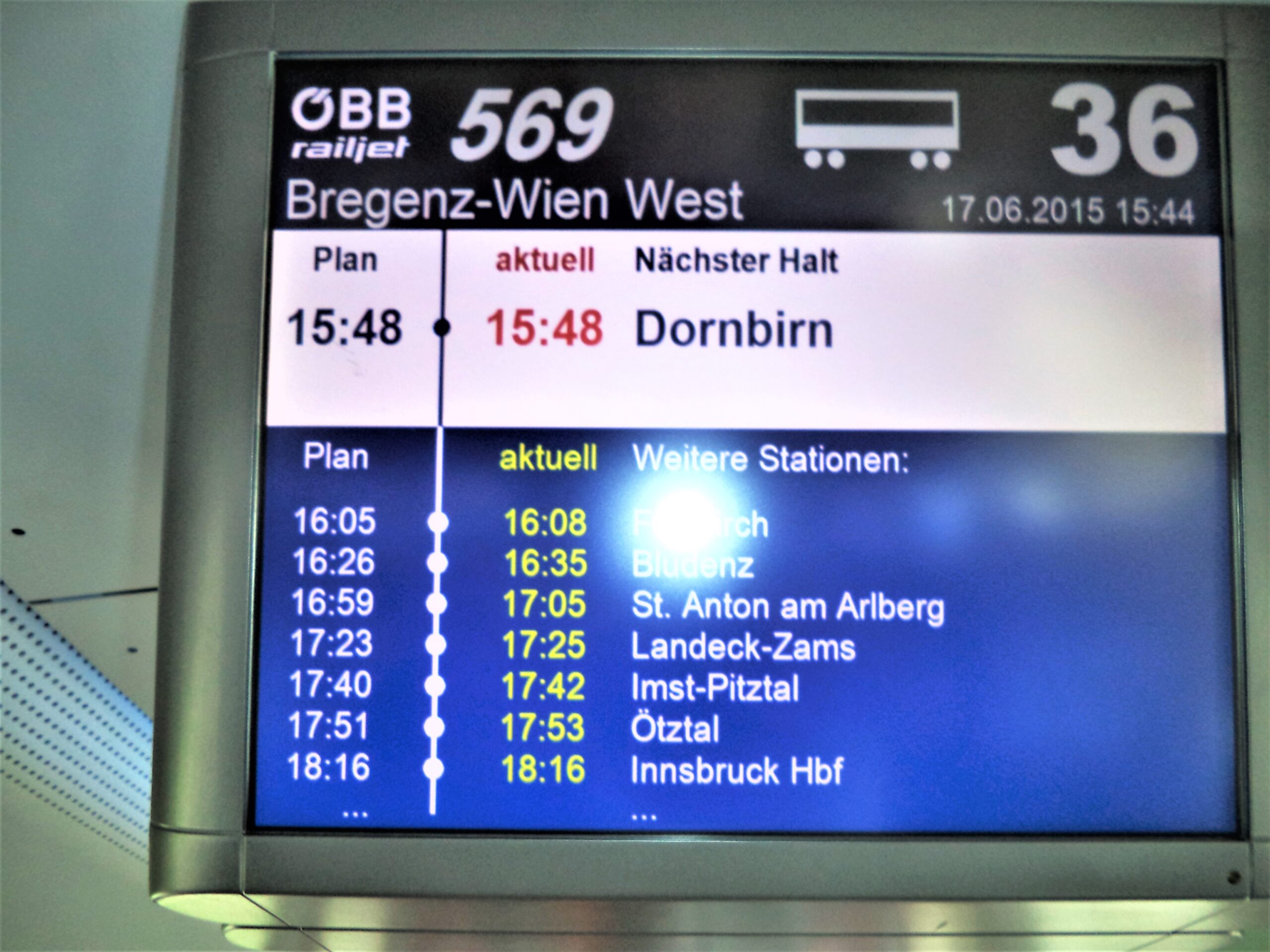
Audio announcements should focus on delivering essential and accurate information, minimising the repetitious announcement about looking after your luggage, slipping on the platform etc.
On tourist trains, brief automated station stop announcements should be multi-lingual (as in many continental countries), also here including Gaelic.
For tourist lines, a mobile phone App providing route commentaries activated by GPS should be available in a choice of several languages.
Consideration should also be given to introducing a premier seating section on tourist trains with a fare surcharge to cover additional catering and customer service.
Electronic seat reservation systems should not allow passengers to book seats from intermediate stations once a train has commenced its journey. This facility, offered by DB and Arriva, can create the unacceptable situation of walk-on full-fare passengers seated on previously available unreserved seats being evicted in mid journey by people who have at the last minute booked discounted tickets and seats from an intermediate station. A future ScotRail reservation system may allow tickets to be bought from intermediate stations after the train has departed from its starting point, but these last-minute ticket purchases should not entitle the purchaser to reserve a seat, as the seat may already be occupied by a full-fare walk-on passenger. Evicting a passenger from their seat in mid-journey is an unreasonable DB practice which could cause particular problems for elderly or infirm passengers with luggage and leaves the victim with a very negative impression of rail travel.
